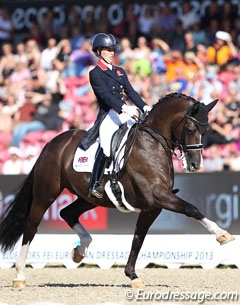
Developing an engaged, active, swinging, rhythmic trot is very difficult to achieve and takes a great deal of technique, feeling and balance on the rider’s part; to allow their horse the room to move freely through the rider’s realm. In the dressage world today, it’s not enough to have a rhythm, swinging trot and to earn yourself the marks that puts you ahead of your relaxed neighbour, but to also show your horse’s expression.
Every horse has a personality and the top combinations will not only ride accurately, they will ride in a manner which allows their horse’s natural expression to shine through. At the dressage convention in the UK Carl Hester spoke about how certain riders can be more comfortable in certain gaits than others and while one rider might find himself more balanced in the canter work, another might feel far more comfortable in the trot. Charlotte, Carl announced, is particularly good at showing an elastic and expressive trot that the judges like to see and while he is more comfortable at the canter, Charlotte is the master when it comes to producing that trot for a nine or even a ten!
The key in creating a trot with expression is in encouragement and allowing the horse’s energy to flow from the back to the front and up through the rider’s body simultaneously, with a lightness and freedom that only comes when the two parts can unite as one unit.
During the demonstration Carl spoke about how Charlotte “would ask the hind legs of the horse to push and then with a very steady hand she would catch the energy” without blocking it at any stage in either her seat, legs and hands. To do this we first need to establish a relaxed trot because energy cannot be generated through a stiff board, but must flow through an open corridor.
When I first started the sitting trot with Batialo and I began to ask for more collection and therefore more impulsion, I found that after 5 strides I became stiff and passing that stiffness onto my horse, he would become tense and the trot would lose its rhythm and balance. Nuno Oliveira used to advise that a rider only goes to sitting trot when he felt the horse moving freely with him. “With a horse in resistance, use the rising trot. If the horse releases, sitting trot. IF needed return to rising trot," he stated.
When I felt that I was losing my own relaxation, I would rise again and push my horse slightly forward, allowing him to open up in front, but being very careful to ensure he didn’t get longer behind, but stepped through and up while I regained my own elasticity of body. Then, I would try again, sitting trot, making sure that as I sat I let the weight go down through my legs, and not letting myself freeze, like a stunned mullet, on the top.
Once I could maintain my own relaxation in the sitting trot, I began to think of where the energy was coming from and going too and where it was being channeled or blocked by my body. This is where we detect if we have a straight horse, or a crooked horse, because energy will not flow freely if ourselves, or our horses are crooked. Then, if we can feel that the energy is coming from the hind legs, we need to channel that energy in the right direction.
“In trot, we must feel that the horse “springs off the ground” by his energy. Feel that he jumps upward and not forward,” Nuno stated. When we feel the upward jump we need to learn not to suffocate that jump and also to ask for more jump at the right moment. Easier said than done. A lot of riders ask constantly for more energy and then block it in their hands.
Charlotte’s brilliance, that Carl was highlighting, was not only in her ability to produce and allow the energy to flow, but also in her ability to catch it with a steady hand, one that didn’t let the energy go, but didn’t block it either. This comes with great feeling and great tenacity, and the rider’s ability to feel their horse’s lift and then feel to what degree that reaches the hand and is regenerated again and again to produce a truly expressive trot for nine, and one day maybe even TEN!!
Text by Sarah Warne
Read all of Sarah's Classical Training Articles here.